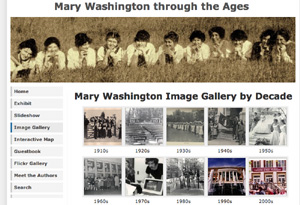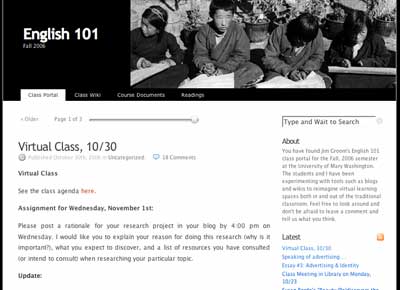 Steve Greenlaw, of Pedablogy fame, noted a while back that the posts on bavatuesdays have been more like reading cuneiform on a tablet (notice the equation of ancient communication with the tablet) than a resource for teaching and learning. To rectify such egregious neglect of the tireless minds that animate the tools, I have decided that over the next couple of posts I will take a look at a few exciting things that have been happening here at UMW lately.
Steve Greenlaw, of Pedablogy fame, noted a while back that the posts on bavatuesdays have been more like reading cuneiform on a tablet (notice the equation of ancient communication with the tablet) than a resource for teaching and learning. To rectify such egregious neglect of the tireless minds that animate the tools, I have decided that over the next couple of posts I will take a look at a few exciting things that have been happening here at UMW lately.
I’ll start with a project that has personally re-invigorated my relationship to writing workshop. I am currently teaching an English 101 class and – having taught this class a multitude of times at CUNY – I was, at first, a bit unenthused. Such a short-sighted approach was soon remedied when I started conceptualizing an approach to teaching this class at the very interesection of my own training which is both as an academic and an instructional technologist. How can I practice what I preach and integrate technology seamlessly and effectively into my teaching? One of the immediate concerns I had was balancing the learning curve for new technologies with solid, rigorous content. I had been in conversation with Mikhail Gershovich, a fellow CUNY Grad Center Ph.D. candidate and Director of the Bernard L. Schwartz Communication Institute at Baruch College (check out cac.ophony for all the great work they are doing there), who specializes in Composition and Rhetoric. He suggested I take a look at David Bartholomae and Anthony Petrosky’s Ways of Reading as the base text for my class.
At first I was a bit concerned about the length and complexity of the readings in Ways of Reading-which range from excerpts of Foucault’s Discipline and Punish to Gloria Anzaldua’s Borderlands/La frontera. I did not want to create a space where the text became a source of dread for the students. On the other hand, however, I also didn’t want the course to degenerate into a series of quick, surface readings that set up the cliche arguments that can make 101 so dreadful for both students and instructors. After looking at the book for a while and working through the thematic organization of the essays I committed to it (unlike the Hammer I am not too legit to committ).
While the essays are difficult, they map out a way of conceptualizing several important intellectual questions that have been quite rewarding. So far we have read four essays from the book: Walker Percy’s “The Loss of the Creature,” John Berger’s “Ways of Seeing,” Susan Douglass’s “Narcissism and Liberation,” and Susan Bordo’s “Beauty (Re)Discovers the Male Body.” These essays have proven powerful in defining the tenor of the class. Percy and Berger’s essays prompted a trip to the National Gallery of Art in D.C.; Douglass and Bordo’s critiques of advertising intitated a quite compelling “cultural studies” research paper in which the students will be tracing the changing nature of a product’s advertising over a particular period of time. As Bruce Campbell would say, “Groovy!”
As with any exciting class, the texts, readings, discussion, and general vibe of the group coalesce into something more than a quantifiable, tangible cause and effect relationship. However, the organizaton of my class within the framework of the web (something I am terming a ‘virtual learning space’) has opened up some really exciting possibilities through which I can augment the readings, discussions and, in particular, the writing workshop.
“How?” you ask impatiently. Well, grasshopper, let me tell you how: Web 2.0! That’s right, with loosely connected tools such as WordPress blogs, a MediaWiki install, YouTube, flickr, and some RSS, this class might provide an interesting model for other writing workshop classes for high schools, colleges, and universities near and far. Now, let me show you how it’s done …
1) Creating a class portal: I am using a single WordPress installation to frame the class (link). This is what I am loosely terming the “class portal.” Here I post announcemnts, youtube videos that reinforce the readings, flickr photsets for discussions, the essay topics, etc. I use the right-hand sidebar as a space for links to the student’s individual blogs (more on this shortly), recent posts, and research links. The tabs in the header offer links to the class wiki, course documents, and readings (which is protected). Overall, this is the one-stop shopping for the students to get to any place they may want to go to in regards to the class, be it administrative or otherwise.
2) Finding a use for the Wiki: a friend and colleague at CUNY one said to me, and I paraphrase here, “I think wikis are cool, but I just don’t know how they can be used effectively in the classroom.” Well Luke, I have been working on this question myself for a bit now, and while I don’t have any definitive answers, I have what you may agree is an interesting starting point. The English 101 class wiki is a variegated combination of things using a MediaWiki install that I linked into the WordPress header:
- It is an interactive calendar that traces the notes, agenda and class activities (including wikified group work) for that particular day (link).
- It is also a space for student to workshop their papers with one another, and while their peer reviews of one another’s work is locked down for logged-in users only, consider this: I have each student read and comment on at least two other students papers that have been posted in the wiki. They must comment on the discussion page that accompanies the essay. After that, I ask them to revise the draft. What is important here is that each of us can closely gauge our individual process of drafting the essay by utilizing the mediawiki version history option. A tool that for many Comp/Rhet folks makes the task of tracking recurring phrasing, syntactical, and grammatical issues that much more effective and easy. In fact, this workshopping method, which we have done several times in class previosuly, was the premise for our first virtual class (link).
- The wiki is a place to collect and build upon resources. I think possibly the most valuable part of a wiki for teaching may be that it is so easily edited and re-used. When I think about it, notes, discusssions, an interactive course calendar, student essays, the syllabus, and other sundries are all in one place online and easily portable to another wiki or reframed within this one. Managing your documents for a class over a semester was never easier, nor was having students turn in work nor tracking down when they did turn it in (the management side of teaching becomes a lot more streamlined for everything is documented for you in the wiki -you simply have to come up with a way of organizing the class materials that makes sense for both you and your students).
3) Student blogs: This is one part of this class I might rethink in another iteration. I had the students sign-up for their own WordPress.com blogs and it was really quite easy for everyone involved. (I am considering using Lyceum Multi-user WordPress blogs next time, for that would give me a little bit more control over each of their blogs in terms of plugins, categories, feeds, etc. But the benefit of WordPress.com is arguably greater because they can use the blogs long after 101 is a mark on their transcript -I guess the techy in me would just like the experimental/laboratory feel of Lyceum). The students are using their blogs to answer reading questions, track their research, publish “more finished” writing assignments, etc. It is also a venue I use often in class to talk about their writing as well as having the students comment upon one another’s blogs before we start the discussion – a variation on the in-class writing assignment.
4) What’s missing? del.icio.us, of course. I have yet to create a del.icio.us account for the class wherein they can share their research links with one another, this must be rectified soon. I’m workin’ on it, #$%#@!
Well, that’s the long and the short of it for now, take a ride around this virtual learning space and let me know what you think. Is this a viable alternative to current course managment systems that you’ve been using lately? Inquiring minds want to now, and don’t worry bavatuesdays will keep it on the Hush Hush.

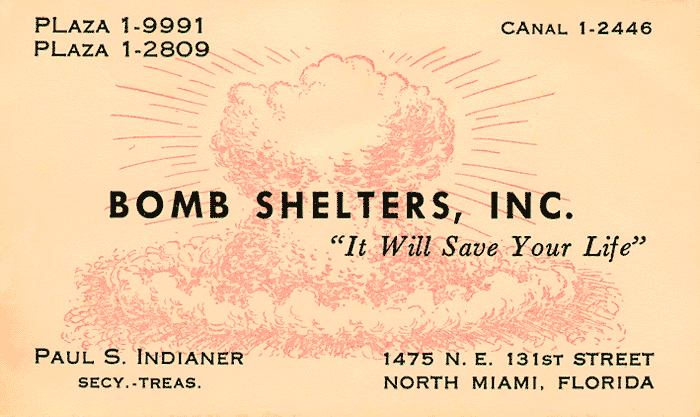

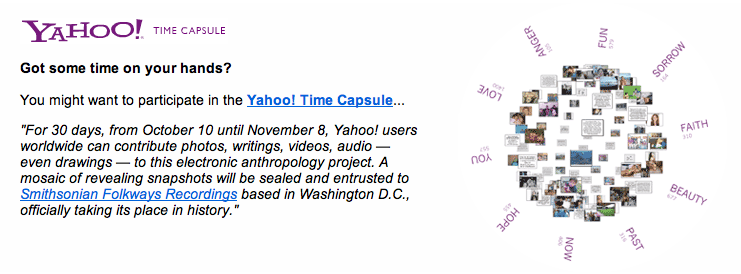
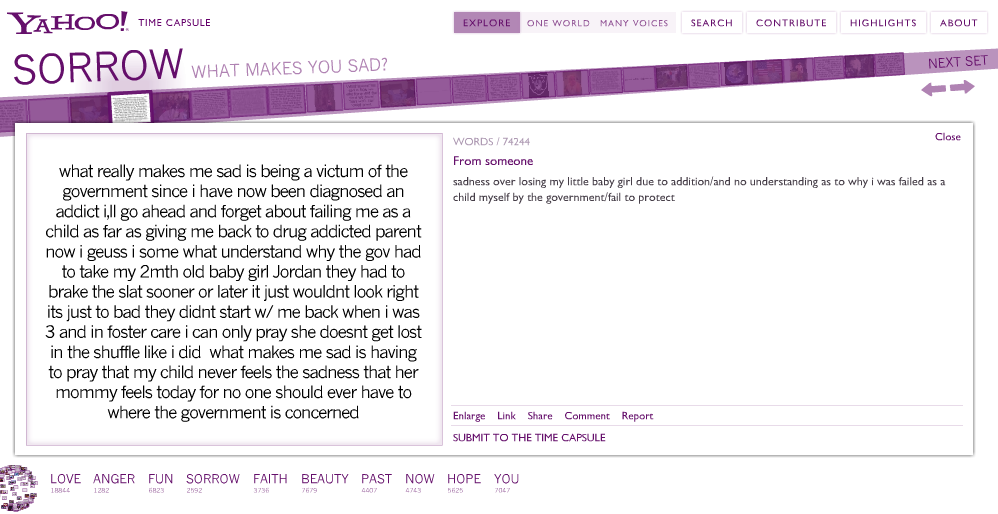
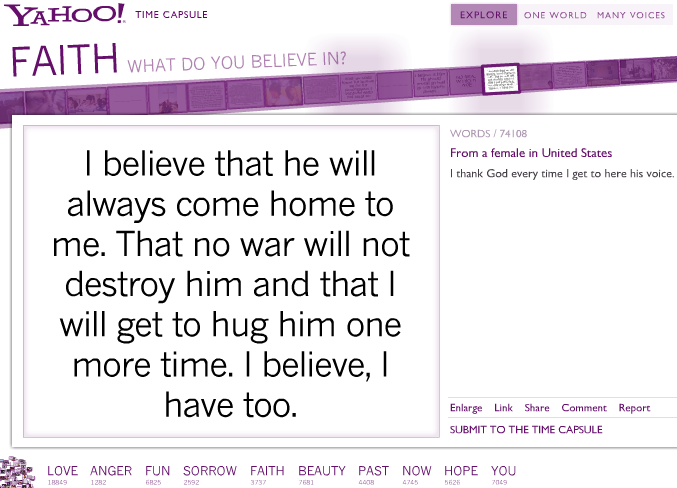

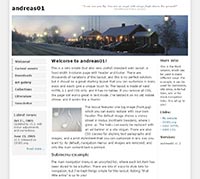 Thanks go to
Thanks go to 
